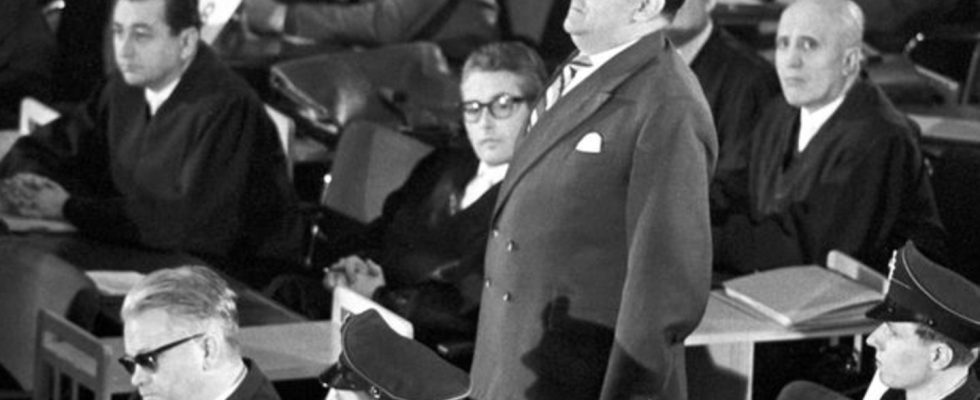December 20, 1963
When the perpetrators of Auschwitz came to trial – and then some were acquitted
The first Auschwitz trial opens in the plenary hall of the Frankfurt city council. In the front row sits the defendant Victor Capesius (with dark glasses), behind him stands the defendant Oswald Kaduk.
© Roland Witschel/dpa
The first trial in the Federal Republic of Germany surrounding the mass murder in Auschwitz began in Frankfurt am Main on December 20, 1963. More than 200 victims testified – but not all of the defendants could be convicted. The reason was a legal principle that was valid at the time.
After the Second World War, Robert Mulka, deputy of Auschwitz camp commandant Rudolf Höß slipped back into a middle-class life almost seamlessly. He was imprisoned for a short time, then the former SS Hauptsturmführer was considered “denazified”.
As early as 1948 he was working as a self-employed businessman in Hamburg and became prosperous. “Like the other defendants in the later Auschwitz trial, he probably no longer feared any consequences,” reports the director of the Fritz Bauer Institute in Frankfurt am Main, Sybille Steinbacher.
The assessment turned out to be wrong. Because 18 years after the end of the war in 1945, his past caught up with him. On December 20, 1963 – exactly 60 years ago – the first Auschwitz trial began in Frankfurt’s Römer. Mulka and 22 other men were charged.
The Auschwitz trial was the largest and longest murder trial to date
This was the largest and longest murder trial in German legal history to date, explains Steinbacher. “He provided the decisive impetus for the political and social debate about the Nazi era.” In the Auschwitz concentration and extermination camp, the National Socialists murdered at least 1.1 million people, mostly Jewish prisoners. They died in the gas chambers or as a result of forced labor, hunger, disease and abuse.
The trials were initiated by the Frankfurt public prosecutor Fritz Bauer, who later gave the research institute its name. The investigation into the trial lasted five years; the indictment against 24 men ran to exactly 700 pages. Until then, all of the accused had lived inconspicuously in the middle of bourgeois society, as can be seen from the book “Auschwitz on Trial”.
For example, Wilhelm Boger, who beat prisoners to death in Auschwitz, worked as a commercial clerk until his arrest. The nurse Oswald Kaduk was considered one of the cruelest SS men in Auschwitz. The pharmacist Victor Capesius had determined which of the new prisoners were still able to work and which had to die immediately in the gas chamber.
More than 200 death camp survivors testified
“Fritz Bauer’s requirement was to provide the defendants with a cross-section of the entire camp,” recalls one of the prosecutors in the trial at the time, Gerhard Wiese, now 95 years old. The now much-honoured farmer was the Hessian Attorney General at the time. Without the commitment of the Jew who was persecuted during the Nazi era, the Auschwitz trial in Frankfurt would not have taken place. A few years ago, Federal President Frank-Walter Steinmeier described Bauer as a “key figure” in the young Federal Republic. With the Auschwitz trial he set a “landmark” and thereby made the country’s return to the global community possible.
Over 200 Auschwitz survivors testified in the historic trial, and the negotiations generated great interest among the German population. “Over 20,000 visitors came during the 183 days of the trial and it was widely reported in the newspapers,” says Steinbacher. None of the defendants could deny that they had been in Auschwitz. But they denied responsibility or even guilt. The prosecution said they were only following orders. Bauer said in a panel discussion after the trial that not a “human word” was spoken by the defendant.
Part of the murder machine – but that wasn’t enough for a conviction at the time
One problem the prosecutors had in the trial was the legal principle, which was valid until the 2010s, that the defendant must be proven to have committed a specific crime. It wasn’t enough for a conviction, at least for aiding and abetting, if he had been part of the killing machine. And so, at the end of the Auschwitz trial in August 1965, three acquittals were announced. Only six of the defendants were sentenced to life imprisonment for murder, including Boger and Kaduk. Mulka and Capesius received several years in prison for aiding and abetting.
July 20, 1944
Ten important audio books on resistance against Nazi terror
See the photo series: Nazi propaganda proclaimed that it was the work of a small clique of conspirators, but that was not the case. To the Gestapo’s surprise, resistance extended through all levels of society. Ten exciting audio books about resistance.


